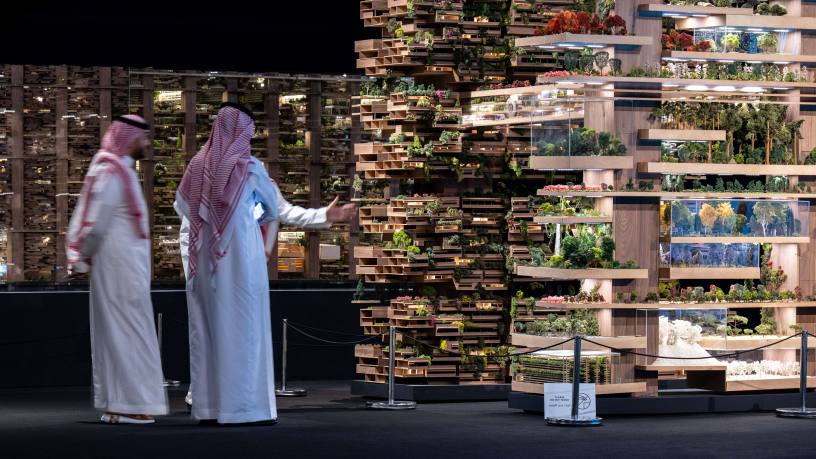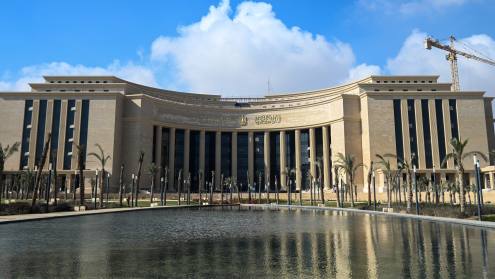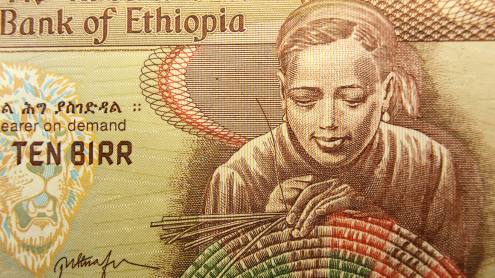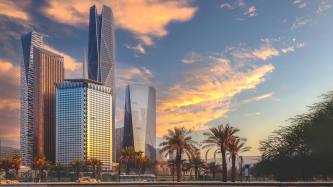Even as oil production cuts eat into Saudi Arabia’s top-line GDP, the country remains one of the most buoyant emerging markets in 2024, supported by ongoing growth in its burgeoning non-oil economy.
The country’s social transformation — which began in earnest eight years ago with the launch of the Vision 2030 programme by Crown Prince Mohammed bin Salman — continues to support the country’s economic growth beyond its long-established hydrocarbon sector, creating jobs for a rapidly expanding local workforce.
Yet while lower oil prices and regional geopolitical risks have had little impact on non-oil business sentiment thus far, questions remain about the capacity of the government to follow through on a growing list of headline-grabbing gigaprojects — to which the Fifa World Cup of 2034 is expected to be added shortly — especially as it struggles to attract foreign direct investment.
After a surge in oil revenues following Russia’s full-scale invasion of Ukraine made Saudi Arabia the best-performing economy in the G20 in 2022, last year saw the country sink close to the bottom of the table. Oil production cuts introduced in October 2022 by Saudi Arabia and the Opec+ bloc and deepened the following April saw the country’s oil economy contract by 9 per cent in 2023, prompting a 0.8 per cent fall in overall GDP.
The cuts — aimed at shoring up prices amid weak global demand — are set to expire in June at time of writing, with production expected to rise again to protect market share in the face of expanding US oil production.
Yet while a similar move 10 years ago saw a dramatic production increase and a slump in prices, more gradual action is expected this time around.
“When production rates increase we’re unlikely to see the same sharp rises that we saw in 2014, as Saudi Arabia and other Opec+ members aren’t going to want to see prices fall as far as they did then,” says James Swanston, a Middle East and north Africa economist at Capital Economics.
Yet while Capital Economics still predicts a 4.5 per cent contraction in the oil economy this year even as production ramps up, overall GDP is forecast to improve to 2.8 per cent on the back of the country’s burgeoning non-oil economy. The sector grew by 4.4 per cent in 2023, with Capital Economics forecasting 4.8 per cent growth this year.
Vision becoming reality
The story of the transformation of Saudi Arabia’s non-oil economy under Vision 2030 is by now a familiar one. Its milestones — the lifting of the ban on cinemas and women drivers, the sale of shares in state oil company Saudi Aramco, the launch of several domestic gigaprojects, heavy state investment in economic diversification initiatives and the dramatic rise in domestic employment — are still worthy of note.
“The magnitude of the changes delivered over the past five years is greater than anywhere else in the region, a marker of the starting point and the scale of the Saudi economy,” said Simon Williams, chief economist for central and eastern Europe and the Middle East and Africa for HSBC, in an April research note.
“The sweep of reforms already delivered to policy-making, the social code, housing market, labour market, industrial policy, the investment environment for private sector and foreign firms, and support for SMEs form just part of a comprehensive overhaul of the domestic economy framed by Vision 2030, and which the IMF estimates can add more than 4 percentage points to potential non-oil growth.”
The country’s labour market remains strong, with 3mn people entering the market since the Covid-19 pandemic, according to HSBC, with official unemployment figures hitting their lowest level in 25 years.
Rising geopolitical tensions in the Middle East, which have had little discernible effect on oil prices to date, have similarly failed to affect sentiment in the non-oil economy. The headline Purchasing Managers Index score for the country’s non-oil economy stood at 57 for March, down slightly on the February figure of 57.2, but well above the 50-point mark that separates growth from contraction, with those surveyed reporting the most substantial uptick in business activity registered in the past six months in March.
“The heightened business activity and increased demand resulted in a notable escalation in purchasing growth, reflecting a dynamic marketplace responding to growing consumer needs,” says Naif Al-Ghaith, chief economist at Riyad Bank, the survey’s sponsor.
“The concurrent easing of cost pressures, particularly in terms of wages, provided companies with greater flexibility and resources to invest in their operations and workforce, fostering a conducive environment for sustained economic progress and development in Saudi Arabia.”
Public spending
In the midst of such optimism, it remains to be seen how sustainable the economic reform process is for the remainder of Vision 2030’s mandate, given the dramatic progress achieved thus far, and the role of massive public spending — above all from the Public Investment Fund, the country’s $940bn sovereign wealth fund — in driving development.
“Going forward there are questions about whether we’re going to continue to see such gains or whether female participation in the workplace — which is still low by international standards — will begin to plateau,” says Tim Callen, a visiting fellow at the Arab Gulf States Institute in Washington.
“There are also questions about whether the huge public spending model that’s been used thus far is the right way to drive transformation.”
A particular challenge is the execution of the country’s flagship gigaprojects — including the $10bn Red Sea tourism development, the futuristic city Neom, and the 170km real estate project The Line — and the enormous funding challenges such projects represent in an environment where private-sector involvement remains relatively low.
“This has led the state to become more directly involved, increasing the sovereign’s direct and contingent risks should costs continue to rise, plans go awry or a drop in oil prices raises central government borrowing needs,” said Williams.
“The scale is also an enormous management challenge for a governing system that has grown in quality, but remains heavily centralised.”
Recent additions to the projects on the country’s books are the hosting of World Expo in Riyadh in 2030, and the Fifa World Cup of 2034, for which the country is the only bidder.
FDI push
The heavy involvement of the state is a response to an ongoing dearth of foreign direct investment in Saudi Arabia’s economy, one of the key priorities of Vision 2030.
The country has overhauled key legal and regulatory structures to provide a more business-friendly environment for overseas investors; 2018 saw the passage of a new bankruptcy law, while a new civil code was introduced in December.
“Such laws and regulations look good on paper but there’s always the question about how such new laws will work in practice,” says Callen.
This year meanwhile has seen the implementation of the country’s “project HQ” programme, obliging multinational companies to establish regional headquarters in the country in order to qualify for government contracts, in a move designed to entice such firms from the UAE.
The Financial Times reported in March that 350 global companies, including PepsiCo, Boeing, PwC and Unilever, had already complied with the edict.
Yet FDI inflows into the country stood at just 1.2 per cent of GDP at the end of 2023 according to official figures, significantly below the official Vision 2030 target of 5.7 per cent of GDP per annum by 2030, let alone the $100bn a year (or 9.2 per cent of GDP) target set by Crown Prince Mohammed bin Salman in October 2021.
“Even after the measures the government has introduced, the business environment in Saudi Arabia remains very relationship-driven, with progress depending on who you know,” says Swanston.
“This remains a deterrent for foreign companies looking to set up in the country, particularly in comparison with the UAE.”
The pressure on some of the country’s largest projects has already begun to show: in early April, Bloomberg reported that the medium-term ambitions for The Line, which the government had hoped would have 1.5mn residents by 2030, have been significantly scaled back. The development is now expected to be just 2.4km long by that date, with only 300,000 residents, the news service reported.
“When oil prices are below the fiscal breakeven price the Saudi government has tended to cut back on capital investment projects rather than current expenditure,” says Swanston.
“Unless the government makes further steps to attract foreign companies and investment, the onus will fall even more on the state and the PIF to finance the Vision 2030 plans.”













